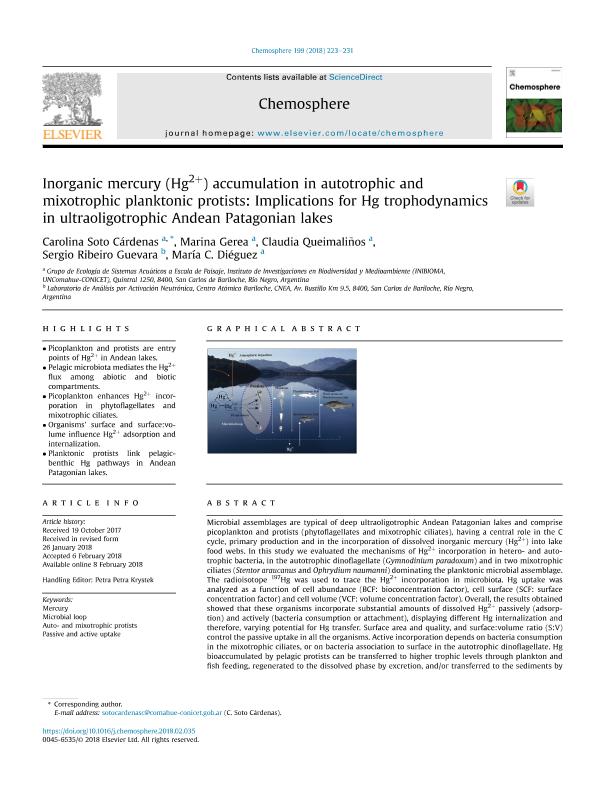Mostrar el registro sencillo del ítem
dc.contributor.author
Soto Cárdenas, Estela Carolina

dc.contributor.author
Gerea, Marina

dc.contributor.author
Queimaliños, Claudia Patricia

dc.contributor.author
Ribeiro, Sergio

dc.contributor.author
Dieguez, Maria del Carmen

dc.date.available
2020-01-09T19:00:37Z
dc.date.issued
2018-05
dc.identifier.citation
Soto Cárdenas, Estela Carolina; Gerea, Marina; Queimaliños, Claudia Patricia; Ribeiro, Sergio; Dieguez, Maria del Carmen; Inorganic mercury (Hg2+) accumulation in autotrophic and mixotrophic planktonic protists: Implications for Hg trophodynamics in ultraoligotrophic Andean Patagonian lakes; Pergamon-Elsevier Science Ltd; Chemosphere; 199; 5-2018; 223-231
dc.identifier.issn
0045-6535
dc.identifier.uri
http://hdl.handle.net/11336/94174
dc.description.abstract
Microbial assemblages are typical of deep ultraoligotrophic Andean Patagonian lakes and comprise picoplankton and protists (phytoflagellates and mixotrophic ciliates), having a central role in the C cycle, primary production and in the incorporation of dissolved inorganic mercury (Hg2+) into lake food webs. In this study we evaluated the mechanisms of Hg2+ incorporation in hetero- and autotrophic bacteria, in the autotrophic dinoflagellate (Gymnodinium paradoxum) and in two mixotrophic ciliates (Stentor araucanus and Ophrydium naumanni) dominating the planktonic microbial assemblage. The radioisotope 197Hg was used to trace the Hg2+ incorporation in microbiota. Hg uptake was analyzed as a function of cell abundance (BCF: bioconcentration factor), cell surface (SCF: surface concentration factor) and cell volume (VCF: volume concentration factor). Overall, the results obtained showed that these organisms incorporate substantial amounts of dissolved Hg2+ passively (adsorption) and actively (bacteria consumption or attachment), displaying different Hg internalization and therefore, varying potential for Hg transfer. Surface area and quality, and surface:volume ratio (S:V) control the passive uptake in all the organisms. Active incorporation depends on bacteria consumption in the mixotrophic ciliates, or on bacteria association to surface in the autotrophic dinoflagellate. Hg bioaccumulated by pelagic protists can be transferred to higher trophic levels through plankton and fish feeding, regenerated to the dissolved phase by excretion, and/or transferred to the sediments by particle sinking. In ultraoligotrophic Andean Patagonian lakes, picoplankton and planktonic protists are key components of lake food webs, linking the pelagic and benthic Hg pathways, and thereby playing a central role in Hg trophodynamics.
dc.format
application/pdf
dc.language.iso
eng
dc.publisher
Pergamon-Elsevier Science Ltd

dc.rights
info:eu-repo/semantics/openAccess
dc.rights.uri
https://creativecommons.org/licenses/by-nc-sa/2.5/ar/
dc.subject
AUTO- AND MIXOTROPHIC PROTISTS
dc.subject
MERCURY
dc.subject
MICROBIAL LOOP
dc.subject
PASSIVE AND ACTIVE UPTAKE
dc.subject.classification
Ciencias Medioambientales

dc.subject.classification
Ciencias de la Tierra y relacionadas con el Medio Ambiente

dc.subject.classification
CIENCIAS NATURALES Y EXACTAS

dc.title
Inorganic mercury (Hg2+) accumulation in autotrophic and mixotrophic planktonic protists: Implications for Hg trophodynamics in ultraoligotrophic Andean Patagonian lakes
dc.type
info:eu-repo/semantics/article
dc.type
info:ar-repo/semantics/artículo
dc.type
info:eu-repo/semantics/publishedVersion
dc.date.updated
2019-10-10T13:46:54Z
dc.journal.volume
199
dc.journal.pagination
223-231
dc.journal.pais
Estados Unidos

dc.journal.ciudad
Nueva York
dc.description.fil
Fil: Soto Cárdenas, Estela Carolina. Consejo Nacional de Investigaciones Científicas y Técnicas. Centro Científico Tecnológico Conicet - Patagonia Norte. Instituto de Investigaciones en Biodiversidad y Medioambiente. Universidad Nacional del Comahue. Centro Regional Universidad Bariloche. Instituto de Investigaciones en Biodiversidad y Medioambiente; Argentina
dc.description.fil
Fil: Gerea, Marina. Consejo Nacional de Investigaciones Científicas y Técnicas. Centro Científico Tecnológico Conicet - Patagonia Norte. Instituto de Investigaciones en Biodiversidad y Medioambiente. Universidad Nacional del Comahue. Centro Regional Universidad Bariloche. Instituto de Investigaciones en Biodiversidad y Medioambiente; Argentina
dc.description.fil
Fil: Queimaliños, Claudia Patricia. Consejo Nacional de Investigaciones Científicas y Técnicas. Centro Científico Tecnológico Conicet - Patagonia Norte. Instituto de Investigaciones en Biodiversidad y Medioambiente. Universidad Nacional del Comahue. Centro Regional Universidad Bariloche. Instituto de Investigaciones en Biodiversidad y Medioambiente; Argentina
dc.description.fil
Fil: Ribeiro, Sergio. Comisión Nacional de Energía Atómica. Centro Atómico Bariloche; Argentina. Comisión Nacional de Energía Atómica. Gerencia del Área de Energía Nuclear. Unidad de Actividad de Ingeniería Nuclear. Laboratorio de Análisis por Activación Neutrónica; Argentina
dc.description.fil
Fil: Dieguez, Maria del Carmen. Consejo Nacional de Investigaciones Científicas y Técnicas. Centro Científico Tecnológico Conicet - Patagonia Norte. Instituto de Investigaciones en Biodiversidad y Medioambiente. Universidad Nacional del Comahue. Centro Regional Universidad Bariloche. Instituto de Investigaciones en Biodiversidad y Medioambiente; Argentina
dc.journal.title
Chemosphere

dc.relation.alternativeid
info:eu-repo/semantics/altIdentifier/doi/http://dx.doi.org/10.1016/j.chemosphere.2018.02.035
dc.relation.alternativeid
info:eu-repo/semantics/altIdentifier/url/https://www.sciencedirect.com/science/article/pii/S0045653518302352
Archivos asociados
